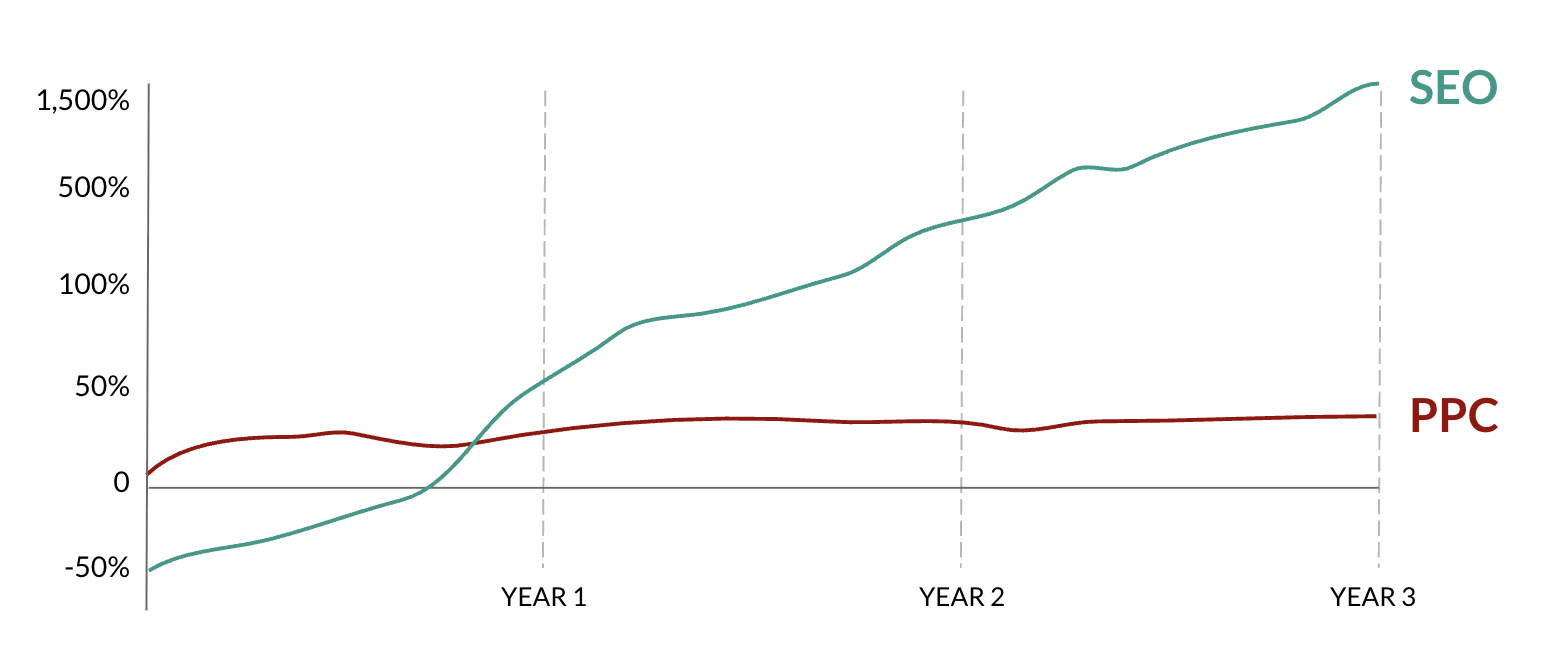SEO vs Ads: Why Destinations Get More ROI from Search

Many destinations pour money into paid advertising simply because the metrics look impressive in board reports: big impressions, immediate traffic, quick spikes. But ads are interruption marketing. They show up when potential customers aren’t expecting them, while they’re scrolling social media, checking the weather, or watching a video and interrupt what they're doing, even though they’re not in the right mindset.
Search is different. When someone types “best small towns near Chicago” or asks Siri for “hidden gems in Michigan,” they’re in planning mode. That's genuine intent. They want ideas and are ready to act on them. Matching your destination with that intent is a smarter marketing strategy because it creates the most direct path to new visitors.
This is where Search Engine Optimization (SEO) comes in. With the right SEO strategy and consistent content creation, your destination can earn visibility in those exact high-intent searches. Simply put: SEO drives organic traffic that helps your destination get found without constantly buying ads. It’s the most cost-effective way to drive traffic over time.
Most destinations ignore this valuable search-driven traffic, choosing instead to chase people with ad campaigns. Meanwhile, potential visitors are actively searching for exactly what you offer, but you're invisible because you’re busy sending google ads to audiences not in planning mode.
For destinations that optimize content for SEO and meet people in these high-intent moments, the impact is measurable and significant.
Why Ads Struggle to Deliver
Ads are like renting a billboard. While it’s up, people see it. Take it down and you disappear. There’s no equity or lasting value. That’s the reality of paid ads like Google ads and other PPC (pay-per-click) campaigns—they deliver immediate results, but they’re inherently short term.
That’s why ads feel like a treadmill. The second you stop paying, the visibility is gone. Even during active campaigns, most travelers scroll past ads. Research indicates a strong preference for organic results: 82% of users ignore paid ads, and 94% trust organic over paid results, heading straight for the organic blue links on the SERPs (search engine results pages) instead.
And even if you do get attention, ads often stay surface-level. They’re fine for promoting an event or boosting brand awareness, but they don’t answer the questions travelers are searching when planning—like “family-friendly bike trails in Michigan” or “holiday events near Chicago.”
That’s where SEO content shines.

The Strategic Benefits of SEO
SEO works because you’re not creating interest—you’re capturing it. After all, the point of everything is to convert. That’s why SEO-led content delivers higher conversion rates, makes better use of your marketing budget, and outperforms all other digital marketing tactics.
The performance difference is substantial:
- SEO (organic) traffic converts up to 8x better than interruption-based ads like display or social.
- Organic search drives 53% of web traffic and more than 40% of revenue.
- Social gets plenty of hype, but it typically accounts for less than 10% of all traffic and even fewer conversions.
Instead of blasting ads and hoping to spark interest, SEO meets travelers who already want what you offer. They stay longer on your site, engage more deeply, and convert faster.
This is qualified demand that converts.
How Travelers Search Today
Google processes an average of 13–14 billion searches a day. Nearly 60% end without a click because quick result answers now appear directly in Google search results, previews or AI overviews. Keeping up with the algorithm means your SEO efforts must focus on quality content and strong user experience. Not shortcuts.
TikTok has become a top-three search engine specifically for Gen Z (aka those under 30). ChatGPT has over 100 million weekly users. Voice search continues to grow as people ask Siri or Alexa what to do nearby.
Ads don’t show up in these places. SEO-driven content does.
Why SEO Wins on ROI (Return on Investment)
SEO builds equity instead of draining the budget. Each page of optimized content becomes a digital asset that compounds over time. Ads and PPC campaigns only rent attention. SEO earns it and retains it.
Spend $5,000 on a digital marketing strategy that relies on paid ads and you’ll see immediate visibility during the campaign. Stop spending and it’s over. Put that same $5,000 into SEO and the results start smaller but grow. A “Best Fall Hikes in [Region]” post published in 2023 can still attract visitors in 2025. That’s long-term growth.
This creates compounding returns through several mechanisms:
Authority Building: Every new optimized page strengthens your overall domain authority. Publish twenty well-researched posts in a year, and you're not just ranking for twenty specific searches—you're building the credibility to appear for hundreds more organic search results.
Seasonal Compounding: Ads for "Holiday Events" disappear on January 1st. A well-optimized holiday guide can dominate search results by its third or fourth season with zero additional investment.
Content Expansion: When a "Family-Friendly Bike Trails" page performs well, you can expand into "Kid-Friendly Outdoor Adventures" or "Best Family Restaurants Near Bike Trails." Each success makes the next one easier to achieve.
This compounding effect explains why SEO delivers the highest ROI for destinations. It's an investment that continues paying.
The Strategic Opportunity
SEO removes the guesswork from destination marketing. With keyword research, you can identify exactly what travelers search for, then create high-quality content that answers those specific questions. (This is actually where Kick Push comes in. We’re awesome at this.)
This shifts your approach from interruption-based advertising to surgical digital marketing—meeting demand that already exists rather than trying to create it.
The Optimal Budget Allocation
Advertising maintains its place in the marketing mix for launches, campaigns, and major events. However, when your entire ad spend flows to a Google Ads campaign, you’re renting all your visibility. With rising cost per click (CPC) rates, the moment payments stop, you vanish.
SEO creates marketing sustainability. Reallocating even 10-20% of advertising spend toward SEO builds assets you own permanently. This high quality content strengthens your online presence, earns lasting organic rankings, and drives steady website traffic from your ideal target audience year-round.
Sustainable growth requires ownership, not rental. The destinations that thrive long-term are building SEO assets today while their competitors remain trapped in the advertising spend cycle. If you’d like to explore what this might look like for your destination, let’s talk.

